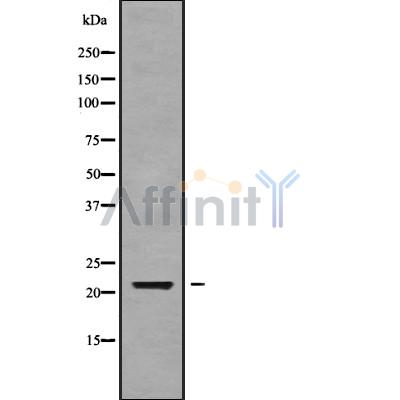CALML6 Antibody - #DF9317
| Product: | CALML6 Antibody |
| Catalog: | DF9317 |
| Description: | Rabbit polyclonal antibody to CALML6 |
| Application: | WB IHC |
| Reactivity: | Human, Mouse |
| Prediction: | Dog |
| Mol.Wt.: | 21 kDa; 21kD(Calculated). |
| Uniprot: | Q8TD86 |
| RRID: | AB_2842513 |
Product Info
*The optimal dilutions should be determined by the end user. For optimal experimental results, antibody reuse is not recommended.
*Tips:
WB: For western blot detection of denatured protein samples. IHC: For immunohistochemical detection of paraffin sections (IHC-p) or frozen sections (IHC-f) of tissue samples. IF/ICC: For immunofluorescence detection of cell samples. ELISA(peptide): For ELISA detection of antigenic peptide.
Cite Format: Affinity Biosciences Cat# DF9317, RRID:AB_2842513.
Fold/Unfold
CAGLP; Calglandulin-like protein; CALGP; CALL6_HUMAN; CALML6; Calmodulin like 6; Calmodulin-like protein 6; EF-hand protein; OTTHUMP00000001117; OTTHUMP00000179025; RP1-140A9.2;
Immunogens
A synthesized peptide derived from human CALML6, corresponding to a region within the internal amino acids.
- Q8TD86 CALL6_HUMAN:
- Protein BLAST With
- NCBI/
- ExPASy/
- Uniprot
MGLQQEISLQPWCHHPAESCQTTTDMTERLSAEQIKEYKGVFEMFDEEGNGEVKTGELEWLMSLLGINPTKSELASMAKDVDRDNKGFFNCDGFLALMGVYHEKAQNQESELRAAFRVFDKEGKGYIDWNTLKYVLMNAGEPLNEVEAEQMMKEADKDGDRTIDYEEFVAMMTGESFKLIQ
Predictions
Score>80(red) has high confidence and is suggested to be used for WB detection. *The prediction model is mainly based on the alignment of immunogen sequences, the results are for reference only, not as the basis of quality assurance.
High(score>80) Medium(80>score>50) Low(score<50) No confidence
Research Backgrounds
Cytoplasm. Nucleus.
Expressed in prostate, thymus, heart, skeleton muscle, bone marrow and ovary.
Belongs to the calmodulin family. Calglandulin subfamily.
Research Fields
· Cellular Processes > Cell growth and death > Oocyte meiosis. (View pathway)
· Cellular Processes > Cell growth and death > Cellular senescence. (View pathway)
· Environmental Information Processing > Signal transduction > Ras signaling pathway. (View pathway)
· Environmental Information Processing > Signal transduction > Rap1 signaling pathway. (View pathway)
· Environmental Information Processing > Signal transduction > Calcium signaling pathway. (View pathway)
· Environmental Information Processing > Signal transduction > cGMP-PKG signaling pathway. (View pathway)
· Environmental Information Processing > Signal transduction > cAMP signaling pathway. (View pathway)
· Environmental Information Processing > Signal transduction > Phosphatidylinositol signaling system.
· Environmental Information Processing > Signal transduction > Apelin signaling pathway. (View pathway)
· Human Diseases > Neurodegenerative diseases > Alzheimer's disease.
· Human Diseases > Substance dependence > Amphetamine addiction.
· Human Diseases > Substance dependence > Alcoholism.
· Human Diseases > Infectious diseases: Bacterial > Pertussis.
· Human Diseases > Infectious diseases: Bacterial > Tuberculosis.
· Human Diseases > Cancers: Overview > Pathways in cancer. (View pathway)
· Human Diseases > Cancers: Specific types > Glioma. (View pathway)
· Organismal Systems > Circulatory system > Adrenergic signaling in cardiomyocytes. (View pathway)
· Organismal Systems > Circulatory system > Vascular smooth muscle contraction. (View pathway)
· Organismal Systems > Environmental adaptation > Circadian entrainment.
· Organismal Systems > Nervous system > Long-term potentiation.
· Organismal Systems > Nervous system > Neurotrophin signaling pathway. (View pathway)
· Organismal Systems > Nervous system > Dopaminergic synapse.
· Organismal Systems > Sensory system > Olfactory transduction.
· Organismal Systems > Sensory system > Phototransduction.
· Organismal Systems > Sensory system > Inflammatory mediator regulation of TRP channels. (View pathway)
· Organismal Systems > Endocrine system > Insulin signaling pathway. (View pathway)
· Organismal Systems > Endocrine system > Estrogen signaling pathway. (View pathway)
· Organismal Systems > Endocrine system > Melanogenesis.
· Organismal Systems > Endocrine system > Oxytocin signaling pathway.
· Organismal Systems > Endocrine system > Glucagon signaling pathway.
· Organismal Systems > Endocrine system > Renin secretion.
· Organismal Systems > Endocrine system > Aldosterone synthesis and secretion.
· Organismal Systems > Digestive system > Salivary secretion.
· Organismal Systems > Digestive system > Gastric acid secretion.
References
Restrictive clause
Affinity Biosciences tests all products strictly. Citations are provided as a resource for additional applications that have not been validated by Affinity Biosciences. Please choose the appropriate format for each application and consult Materials and Methods sections for additional details about the use of any product in these publications.
For Research Use Only.
Not for use in diagnostic or therapeutic procedures. Not for resale. Not for distribution without written consent. Affinity Biosciences will not be held responsible for patent infringement or other violations that may occur with the use of our products. Affinity Biosciences, Affinity Biosciences Logo and all other trademarks are the property of Affinity Biosciences LTD.
